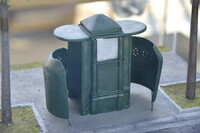| dc.coverage.spatial | Site: Musée de la Civilisation (Québec, Québec, Canada) | en_US |
| dc.coverage.temporal | model 2013-2014 (exhibition) | en_US |
| dc.creator | unknown (Canadian model maker) | en_US |
| dc.date.accessioned | 2016-06-21T18:52:07Z | |
| dc.date.available | 2016-06-21T18:52:07Z | |
| dc.date.issued | 2016-06-21 | |
| dc.identifier | 264183 | en_US |
| dc.identifier.other | archrefid: 3303 | en_US |
| dc.identifier.uri | http://hdl.handle.net/1721.3/180241 | |
| dc.description | Overall view, looking down at model; Scale model, part of the Paris on Stage: 1889-1914 exhibition held June 19, 2013 to February 23, 2014. A pissoir or vespasienne is a structure that provides support and screening of urinals in public space. In 1877 single, columnar pissoirs were replaced by multi-compartmented structures called vespasiennes, in reference to the 1st-century Roman emperor Titus Flavius Vespasianus, who placed a tax on urine collected from public toilets for use in tanning. At the peak of their spread in the 1930s there were 1,230 pissoirs in Paris, but by 1966 their number had decreased to 329. By 2006 only one remained, on Boulevard Arago. Source: Wikipedia; http://en.wikipedia.org/wiki/Main_Page (accessed 6/25/2015) | en_US |
| dc.rights | © Scott Gilchrist, Archivision, Inc. | en_US |
| dc.subject | architecture | en_US |
| dc.subject | City planning | en_US |
| dc.subject | belle époque | en_US |
| dc.subject | fin de siècle | en_US |
| dc.subject | sewage | en_US |
| dc.subject | public toilets | en_US |
| dc.subject | public health | en_US |
| dc.subject | Nineteenth century | en_US |
| dc.title | Vespasienne (pissoir) Model | en_US |
| dc.title.alternative | Paris on Stage: 1889-1914 [exhibition]; Vespasienne (pissoir) Model | en_US |
| dc.type | image | en_US |
| dc.rights.access | Licensed for educational and research use by the MIT community only | en_US |
| dc.identifier.vendorcode | 1A2-F-P-LAVM-A02 | en_US |
| vra.culturalContext | French Canadian | en_US |
| vra.technique | construction (assembling) | en_US |
| vra.worktype | pissoir | en_US |
| dc.contributor.display | unknown (Canadian model maker) | en_US |

